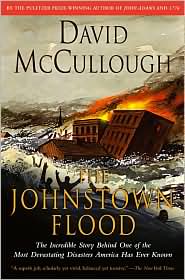 Johnstown, PA is famous for its floods.
Johnstown, PA is famous for its floods.I've always known a little bit about the town because my dad lived there until middle school. My dad took my sister and me for a ride on the Inclined Plane, which was built after the 1889 flood as a precaution for future flood victims. It did indeed save lives during later floods, but has mostly served commuting steelworkers and tourists.
The Inclined Plane is a huge steel car (it holds 65 people) that runs up the side of a huge hill (the track is 867 feet long) at a grade of 71%. You can board it in downtown Johnstown and ride it directly up to the residential neighborhoods high above the town, and vice versa. At the top is a little gift store where you can buy snow globes and mugs and things like that.
Johnstown's location is a little ridiculous. It's your basic flood bait:
The city was built on a nearly level flood plain at the confluence of two rivers, down at the bottom of an enormous hole in the Alleghanies. A visitor from the Middle West once commented, "Your sun rises at ten and sets at two," and it was not too great an exaggeration. (The Johnstown Flood, p. 24)My grandma Cookie (Carol Schmidt) is buried in Grandview Cemetery - aptly named; this cemetery has some of the most breathtaking and somehow distinctly American views you'll ever find. Along with Cookie, most of the 2,209 victims of the 1889 Johnstown flood are buried at Grandview, overlooking lower Johnstown and the surrounding mountains. My Uncle Doug has already reserved and paid for his own future plot at Grandview. Nerd.
So, May 31, 1889. A dam bursts high above Johnstown, at the South Fork Fishing and Hunting Club (a summer resort for men like the Andrews Carnegie and Mellon). Behind the dam was an entire manmade lake; it had been a long-running joke in Johnstown and other surrounding towns that it was just a matter of time before the shoddily-made and already patched-up dam would give way.
The water from the dam and the two rivers rushed down the mountains, leveling everything in its way and gathering all kinds of terrible debris. The situation of the town was such that the water just shot down a wedge toward it, with nowhere for the water to spread out or slow down.
So, you can imagine. I'll leave the gory details to David McCullough.
Though there were two other major floods (in 1936 and 1977), this is the famous Johnstown Flood. 2,209 died; 777 remain unidentified.
I couldn't stop reading this book. The story is fascinating for obvious reasons. The astounding neglect and complacency leading up to the disaster brings to mind the situation in New Orleans before Hurricane Katrina (though the aftermath of this flood was of a much more honorable and efficient character...you know, as opposed to sick and disgraceful and embarrassing). The back story of the dam is kind of crazy, and worth reading in its own right.
Throughout, McCullough tells the story of the flood through the eyes of those that experienced it. In addition to the horror and human interest, there is a lot of humor in the book. My favorite little nugget:
[James] Walters had made one of the day's most extraordinary voyages, having been swept from his home on Walnut Street on top of a roof which took him spinning across town until he smashed into the side of Alma Hall, flew headlong through a window, and landed square in the middle of his own office. (p. 169)If you're a fan of history, pick this up for sure. If not, you might still enjoy it. It's a quick read, not dense at all. Honestly, I'm not sure why the Johnstown Flood doesn't get more play. It's got everything: hubris, class controversy, tragedy, industry, courage, spectacular scenes, Americans Doing Good and Pulling Together, etc. I admittedly bring some personal weight to it as a reader, but I would recommend it heartily to anyone, family history or no.
No comments:
Post a Comment